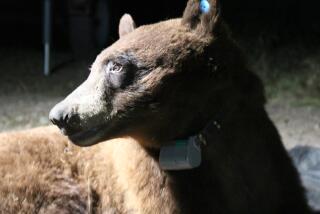Katmai Park Officials Fear Growing Crowds May Lead to Bear Attacks : Alaska: Tourists have discovered this premier fishing hole--and the resident bears. Some even come to the park for the day, dressed in evening gowns and high heels, to watch the creatures.
- Share via
BROOKS CAMP, Alaska — They are swift, massive, hungry and dangerous. But more and more, the brown bears that pull sockeye salmon from Brooks River are just crowded.
An upsurge in visitors to this world-famous fishing hole has officials at Katmai National Park and Preserve fretting about a growing potential for run-ins between the bears and people.
Park officials are considering a list of measures--enlarging viewing platforms, limiting the number of visitors or even shifting the entire camp several miles away--to reduce the risk of bloodshed.
“You see the bears plodding around, ambling along. But their speed is incredible,” said Stephen Hurd, the park’s chief ranger.
Until a few years ago, Katmai was one of the best-kept secrets in the national park system. Getting there requires a trip to Anchorage, another 290-mile hop to King Salmon, then a trip by floatplane or charter boat to Brooks Camp for a stay at the lodges or campground.
But visitor growth has increased about 10% a year since the early 1980s. It has gone from about 11,000 in 1981 to nearly 50,000 in 1989, and the trend is expected to continue, officials said.
Recently, the day visitor--someone who flies in during the morning and flies out again at night--has brought accommodations to the saturation point.
“In one day, people can get into a plane in San Diego or Michigan and come out here in long dresses or high heels--we’ve seen that--and view bears in the wild,” Hurd said.
He said tour companies also are getting into the act, working with the park concessionaire. “That concentrates a lot of people into a small area.”
Still, “We have a miraculously fine (safety) record,” said Ron Squibb, another ranger. “There hasn’t been an incident here since 1966 or ‘67, when a bear drug a guy out of his sleeping bag in the campground. Apparently the guy had been cooking in his tent.”
The camper was cut and bruised but was not seriously hurt. Another visitor, a fisherman, suffered a “Band-Aid-quality cut” on his leg a few years ago when a bear went after salmon he had left on the river bank, Squibb said.
To ensure that safety comes first--and that bears are ceded the right of way--visitors are given an orientation speech upon arrival:
* Campers must cook in areas away from their tents and store their food and cooking utensils in a cache about 14 feet high.
* Photographers are barred from approaching within 50 yards of any bear; 100 yards from a sow with cubs.
* Fly fishermen are allowed to keep one fish of any species per day and must bring their catch to an enclosed cleaning shed immediately after landing it. Otherwise, it’s catch and release.
* When bears enter the 1 1/2-mile-long river, anglers exit.
Rangers are on hand at the lodge or on the trails to enforce these edicts.
“Normally we try to chat with them, give them so much information about ‘Don’t feed the bears’ that they don’t do that,” Hurd said. “Our real concern is that they (bears) not get their fish from fishermen and start looking at humans as a food source.”
For centuries, the mouth of the Brooks River has been a popular fishing spot. Trophy-size rainbow trout as well as salmon, grayling and Arctic char frequent the cold, clear water.
Where bears were once rare, and were shot while stealing fish from drying racks, people now simply shoot photographs as the animals forage among thick schools of salmon moving upstream to spawn.
“As more and more people showed up and they weren’t hurting the bears, it (the river) became a mutual thing. You’ve got resident bears there now,” said Raymond Peterson, 78, co-builder of Brooks Lodge and still the concessionaire.
Peterson says he’s in full agreement with the National Park Service--all measures must be taken to ensure that the bears do not come to associate people with fish. Still, he thinks the risks are exaggerated and he sees no reason to pick up the camp and move it away.
“You’ve got a lot of Chicken Littles out there,” he said. “In Glacier (National Park), the grizzlies are meat eaters. Ours are fish eaters. You need controls, but I think it’s overplayed.”
Park planners, he said, “should be people-oriented instead of bear-oriented.”
Alan Eliason, appointed in June as superintendent of the 4-million-acre park, sees no conflict between safeguarding bears and protecting humans. He and his colleagues are drawing up a long-term management plan to do just that.
“Given more money, we could increase personnel or expand the viewing areas,” Eliason said. “We’re also looking at McNeil (River State Game Sanctuary), to see how the state manages people at that viewing area. What I guess I’m saying is that there’s some potential here for a quota system.
“We also could move the camp and bus people back to the river.”
Eliason said no cost projections have been made and he concedes that none of those moves would be popular. Even expanding the viewing platform near Brooks Falls from its current 25-person capacity might offend those seeking a less crowded wilderness experience, he said.
Hurd, the chief ranger, says a bear attack could happen any day. “But at the same time, a plane could crash out there,” he said.
Still, he said: “If people follow our guidelines and give bears room, I think we can continue as we are for a long time.”
More to Read
Sign up for The Wild
We’ll help you find the best places to hike, bike and run, as well as the perfect silent spots for meditation and yoga.
You may occasionally receive promotional content from the Los Angeles Times.






